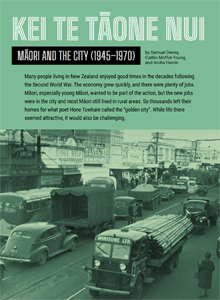Kei te Tāone Nui: Māori and the City (1945–1970)

by Samuel Denny, Caitlin Moffat-Young, and Aroha Harris
The post-Second-World-War era in Aotearoa New Zealand saw one of the fastest rates of urban migration in the world, with Māori migrating to cities in large numbers to take advantage of new economic opportunities. The “golden city” offered much, but it came at a high price. Despite an unquestioned narrative in Pākehā communities that New Zealand’s race relations were world leading, Māori moving to the city encountered prejudice and discrimination at many levels. Māori responded to these challenges in multiple ways, for example, by establishing formal and informal groups that strengthened collective expression of Māori cultural values and practices. By gathering together to debate and take action on key issues, the seeds were sown for the modern Māori protest movement as well as the forging of a new urban Māori identity.


 Literacy Online home
Literacy Online home
